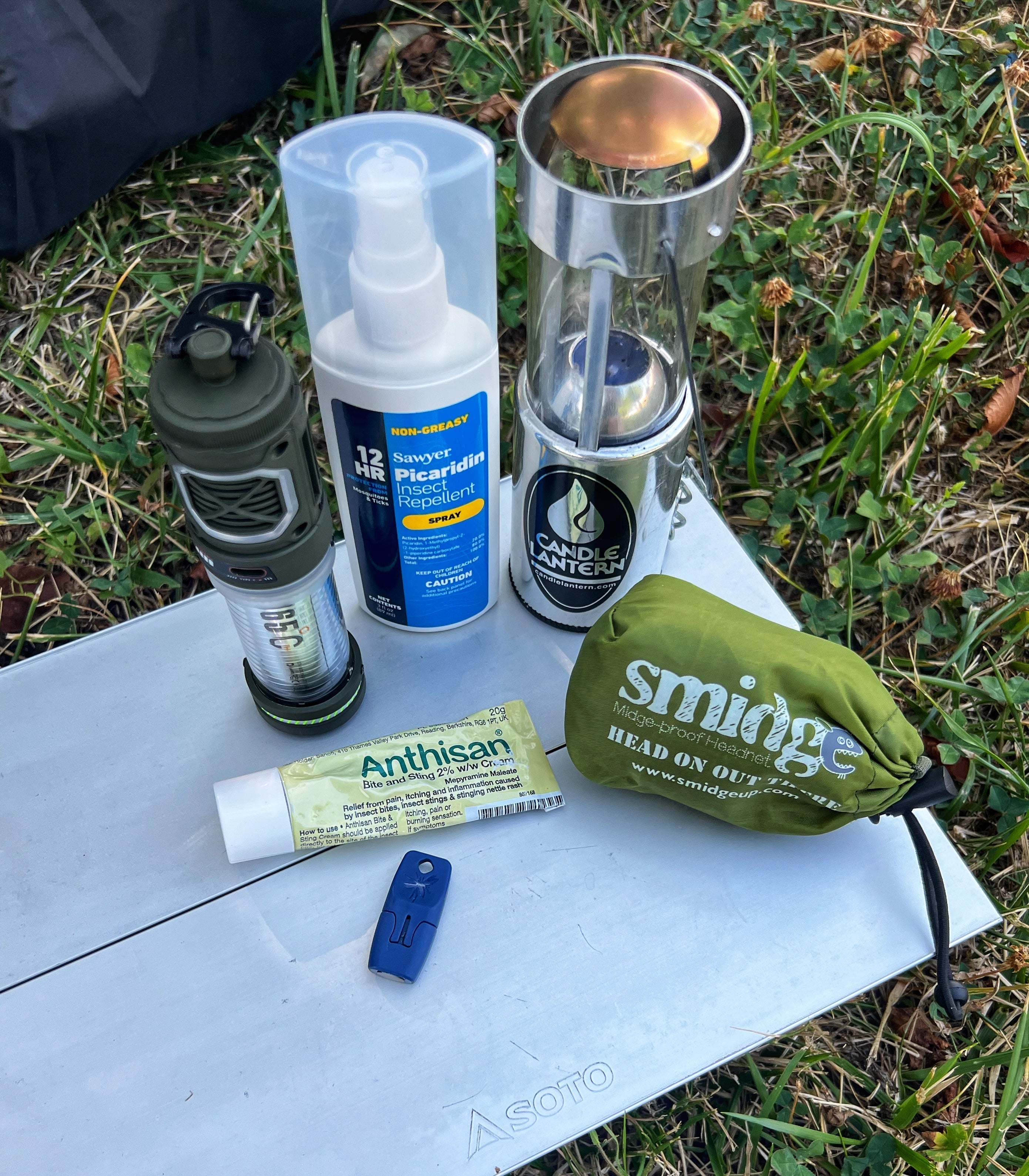🦟 The Great Outdoors vs. Tiny Vampires: A Camper’s Survival Guide

There’s a moment in every camper’s life, somewhere between the crackling fire and the quiet call of an owl when it happens. A tiny high-pitched zzzzzzzzip near your ear. And suddenly, you’re not in a tranquil forest anymore. You’re in the opening scenes of a horror movie.
Mosquitoes, midges, biting flies, and other winged menaces can turn a dream campout into an itchy, red-dotted regret. But do not worry. You are not alone. And there is definitely no reason why you should be unarmed.
Mosquitoes are nature’s way of reminding us we’re delicious. Whether you’re deep in the woods or pitched up in a Yorkshire field, these winged vampires always seem to know where the party is and it’s always your skin. This post isn’t just a bug rant. It is a field guide, a product roundup, and a slightly delirious recounting of personal trials in the buzzing trenches.
Here’s your funny but effective field guide to fighting back… and winning.
Let’s get into it.
⸻
🧪 First, Let’s Talk Science: Why Are Mosquitoes So Obsessed With You?
Mosquitoes aren’t just annoying, they are strategic. They’re drawn to:
• Carbon dioxide from your breath
• Body heat (campfires don’t help)
• Sweat and scent (your fancy natural deodorant? Yeah, not helping)
• Dark clothing (time to reconsider that all black ninja tent setup)
Some mosquitoes can track you from over 100 feet away. And the worst part? They don’t just bite. First they buzz. Then they bite. Then they come back for seconds like you are the all you can eat buffet.
⸻
☂️ Prevention Is Your First Line of Defense
Before we dive into your toolkit of gadgetry and modern mosquito warfare, here are some solid tips worth repeating:
• Choose your camp wisely: Location matters, stay away from stagnant water which is essentially a mosquito maternity ward, long grass, and swampy sites. Mosquitoes love moisture almost as much as they love you.
• Avoid standing water: That dreamy lakeside view, they like it too.
• Wear long sleeves/pants: Bonus points for light colors and loose fitting fabrics. And no, the Hawaiian shirt doesn’t count.
• Get a breeze going: Even a small fan helps, mosquitoes are lazy fliers.
• Timing is everything – Dawn and dusk are peak feeding times. That early morning brew? Prime bite o’clock.
• Camp hygiene – Avoid perfumed soaps and deodorants, clean up food scraps, and most importantly, seal up that tent!
All sound advice, but let’s be real — sometimes, even if you’re doing everything right, they still find you. So, here’s the kit I trust for when the buzzing starts.

⸻
🧰 Gear Up: Your Anti-Mosquito Arsenal
Here’s where the good stuff comes in. You’ve tested these in the wild, and they’re solid enough to recommend in your sleep (literally).
⸻
🔥 Flextail Tiny Repel
This pocket sized powerhouse is a rechargeable, lightweight alternative to those chemical burning mosquito coils. It uses heat activated mosquito repellent mats and can hang from your tent, sit on your table, or clip to your backpack while you hike.

• Silent operation (no buzzing, zapping, or humming)
• USB-C rechargeable
• Three modes: low, high, and camping beast mode
• Safe insert options: While it ships with Flextail’s own, it’s compatible with popular mats like Thermacell’s Allethrin-based ones—which are widely available and effective.

🎯 Pro tip: Use a safe, tested insert to avoid releasing sketchy fumes into your ultralight dreams. Thermacell’s ones are tried-and-true.
The Flextail Tiny Repel earns praise for being a USB-powered bug shield that doubles as a lantern, with a 10‑foot repellent zone and up to 10 hours of battery life. I love how quiet, portable, and rechargeable it is. It uses prallethrin and meperfluthrin to create a small chemical “bubble” around you. The repellent different pads can be inconsistent and are best suited for personal use, not a whole campsite. Just remember: it is More of a sidekick than fortress, Great for solo coverage or a two-person bubble, less so for large windy campsites.

⸻
🧴 Sawyer Picaridin Insect Repellent
This is the stuff that makes the DEET crowd jealous.
Picaridin vs. DEET—what’s the deal?
|
Picaridin |
DEET |
|
Doesn’t melt plastic or gear |
Might ruin your nice sunglasses |
|
Less greasy |
Classic greasy feel |
|
Odourless or lightly scented |
That “bug spray” smell |
|
Just as effective |
Same protection time |
Sawyer’s formula is 20% Picaridin and lasts up to 14 hours. It’s safe for children, gear-friendly, and doesn’t make you smell like a science experiment. Apply once and forget it.
🧴 DEET vs. Picaridin: Bug Spray Battle Royale
When it comes to not getting eaten alive outdoors, two heavyweights step into the ring: the classic DEET and the modern contender, Picaridin.
DEET has been fighting the bite since it was brewed up by the U.S. Army in 1946. It’s tough, proven, and widely trusted. But it’s not perfect, it can feel greasy, smells like bug spray (because, well, it is), and has a weird vendetta against plastics. DEET is effective, but it’s got attitude. Do you want your sunglasses melted into oblivion? In rare cases, high concentrations of DEET have been associated with skin irritation, headaches, and even neurological symptoms, so follow directions and avoid overuse. DEET is a documented neurotoxin, meaning it can negatively impact the nervous system.

Then there’s Picaridin, the sleek, Euro-born newcomer from the ’80s. It’s based on compounds from pepper plants, but don’t worry, it won’t sneeze you out of the tent. It’s odorless, non-greasy, and plastic friendly, meaning it plays nice with your gear. Oh, and it’s just as effective (maybe slightly more so) against both mosquitoes and ticks.
💡 Bottom line?
• Both work brilliantly when used properly
• DEET’s got the longer history, but it’s the messier cousin
• Picaridin feels nicer, smells like nothing, and won’t eat your watch strap
• Go for 20% Picaridin or 25–30% DEET for solid coverage
Whichever you choose, make sure it’s on before the bugs find you. Bonus points if you don’t spray it directly into your eyes mid-hike.
⸻
🕸️ Smidge Head Net
This one’s for the Scottish campers. Or anyone who’s ever asked, “What’s smaller and more annoying than a mosquito?” Answer: the mighty Highland midge.
The Smidge Head Net is made with the finest mesh on the market, fine enough to stop midges but breathable enough not to make you feel like you’re inside a ziplock bag.
• Super lightweight
• Elastic neck drawcord
• Stuffs into a tiny pouch

Pair it with Smidge spray or Picaridin for a two-punch solution. Trust me: if you’re camping anywhere near Scotland, this is worth its weight in haggis… It’s worth mentioning that this also fits over a hat, so it is away from your head and face that little bit more.
⸻
🔥 Heat-It: Tick and Bite Relief
Not every bite can be prevented. But if one gets through, this clever little gadget has your back. The Heat-It connects to your smartphone’s charging port and uses heat therapy to reduce itch and swelling. I have the apple lightening version, there is a USB-C version as well. Mine stays on as little keyring with a Classic SD and a Nitecore Tiki, usually riding in the hip belt of my pack.

• Drug free
• Super compact
• Works on mosquito bites, wasp stings, and even some allergic reactions
Is it magic? No. Is it better than scratching until your ankle looks like a topographic map? Yes.
If mosquitoes treat you like a five star buffet, the Heat It gadget is your revenge. This fingertip sized dongle plugs into your phone, cooks the bite for a few seconds. The treatment’s short, sweet, and effective, just long enough to stop the itch without making your skin feel like a fried egg. Generally, you have relief after just one zap, though it’s crucial to follow the app’s instructions… yes there is an app for it… (“longer is better,” is not the correct mindset with it). It’s clever, compact, and despite my initial skepticism, it works. So yes, if mosquitoes see you as a walking snack, this thing’s worth a shot. I really love this and it stops the itch and ultimately helps the bites go even quicker.

⸻
🎪 When All Else Fails, Laugh
Sometimes, despite your best efforts, a mosquito will find a way in. Probably under your watch strap. Or during a midnight pee.
But if you’ve got your head net on, your Tiny Repel burning silently beside you, a swipe of Picaridin, and a birthday cake cooling in your Hajka oven, you’ll still come out ahead.
Camping is always a little chaotic. Mosquitoes and beasties are just part of the madness. But with the right tools, you can swat, spray, shield, and laugh your way through even the buzziest weekends.
There’s always a chance to dab a bit of the anthisan cream on and provide a bit of relief if you just can’t bear it…
⸻
🏕️ Final Tips
• Keep your tent zipped - no excuses, even for that “just one minute” trip!
• Don’t rely on citronella candles alone, they smell lovely, but they’re more mood lighting than mozzie defense
• Keep repellent and relief gear easily accessible (not buried in your rucksack under your spare socks)

⸻
Hold up…
I know what you’re thinking, “he’s not even mentioned the classic citronella candle that is beloved by campers”. Yeah… the campers who enjoy the illusion of protection..! They smell like a spa and flicker like hope… but scientifically, they’re about as useful as a birthday candle in a hurricane. Studies show they don’t actually do much against mosquitoes. So unless you’re hoping to seduce a swarm with ambiance, stick to actual repellents. Your vibe might suffer, but your ankles will thank you. That being said… I may, on occasion, still have my UCO candle with me with a citronella candle in it… for the nostalgia, of course… well… as part of the whole kit, trying to banish them all..!
———
Got Your Own Mozzie Based Horror Story or Camp Tip?
We’d love to hear it. Drop it in the comments, tag us in your itchy photos, or share your own bite fighting gear picks. Until then, happy camping and don’t let the mozzies bite.


2 comments
In Malaysia, the citronella is oil is either extracted and made into a light lotion or we whack the plant to release the oils. If you don’t get malaria, then it worked🤣.
Nice and comprehensive and gives folk a good head start. Doesn’t matter who you speak to about this. Anyone with experience knows that topical protection and covering up is key just as you’ve said. The creative uses of the heated mat repellers (the advice you gave to banish the blighters with a quick expose to it in my outer tent worked well) still needs exploring more. Nicely written….enjoyed that one and I hadn’t seen the Heat It device! I do like after bite ammonia it works well and I’ve used the clickers they’re not too bad.